Analysis of Entrepreneurship Concepts and Dyson Ltd. Business Model
VerifiedAdded on 2022/08/15
|12
|2605
|11
Report
AI Summary
This report provides a detailed analysis of entrepreneurship, focusing on the concepts of entrepreneurial motivations, processes, and themes, using Dyson Ltd. as a case study. It explores James Dyson's journey, from invention to building Dyson Ltd., highlighting the internal and external factors influencing his entrepreneurial drive, including his focus on innovation and supporting engineering students. The report outlines the entrepreneurial process, including the solo, network, bootlegging, and formal team phases, as experienced by Dyson. It then delves into entrepreneurial themes like product development, pricing, and competitive advantage, and how Dyson implemented them. Furthermore, the report examines the academic models, specifically Dyson's use of a simple and informal academic model and Porter’s five forces, discussing their impact on the company's strategies and growth. The analysis covers Dyson's challenges, including relocation decisions, and how the company adapted to market changes. The report concludes by emphasizing the significance of motivation and academic models in entrepreneurship, using Dyson Ltd. as a practical example.
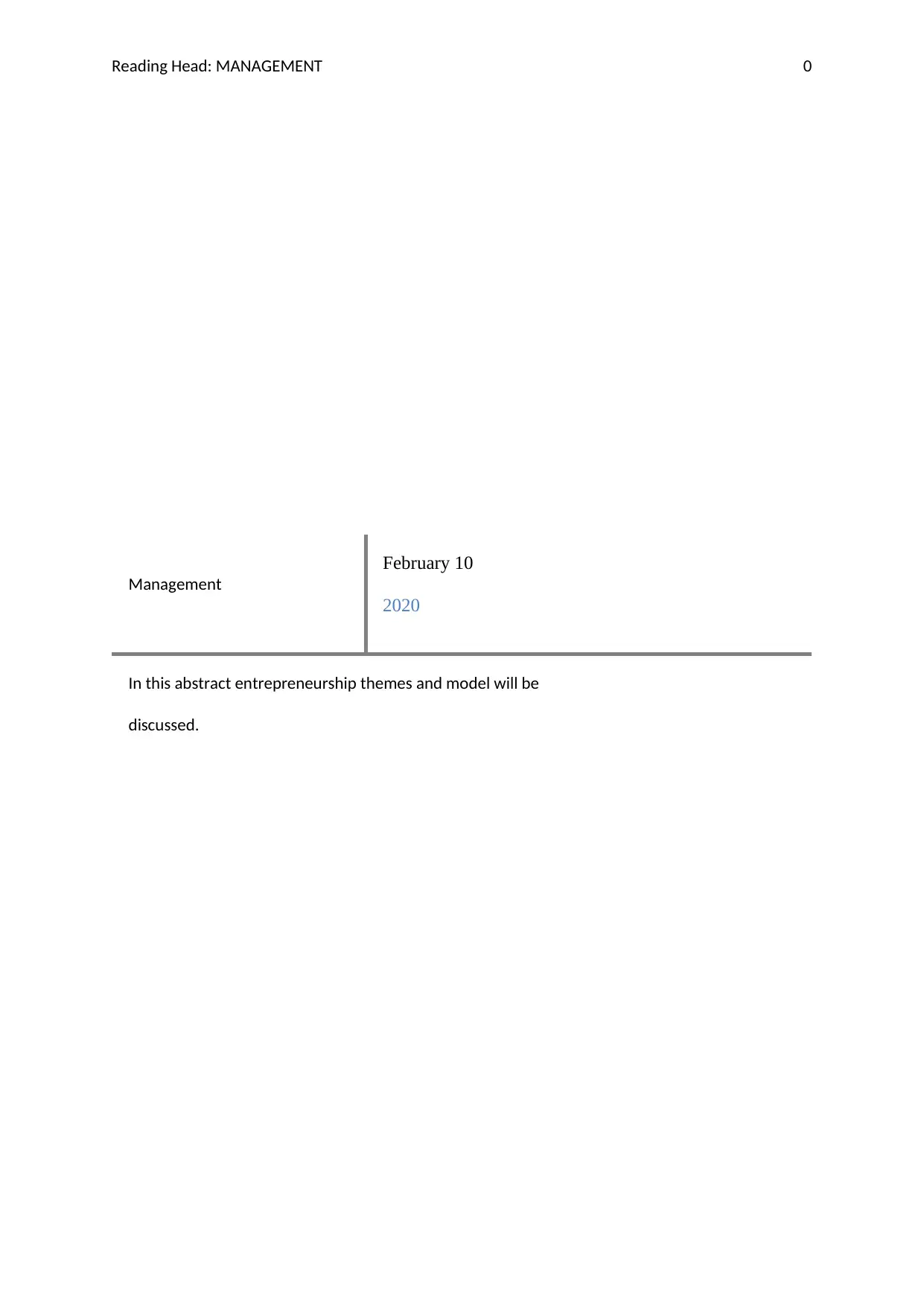
Reading Head: MANAGEMENT 0
Management
February 10
2020
In this abstract entrepreneurship themes and model will be
discussed.
Management
February 10
2020
In this abstract entrepreneurship themes and model will be
discussed.
Paraphrase This Document
Need a fresh take? Get an instant paraphrase of this document with our AI Paraphraser
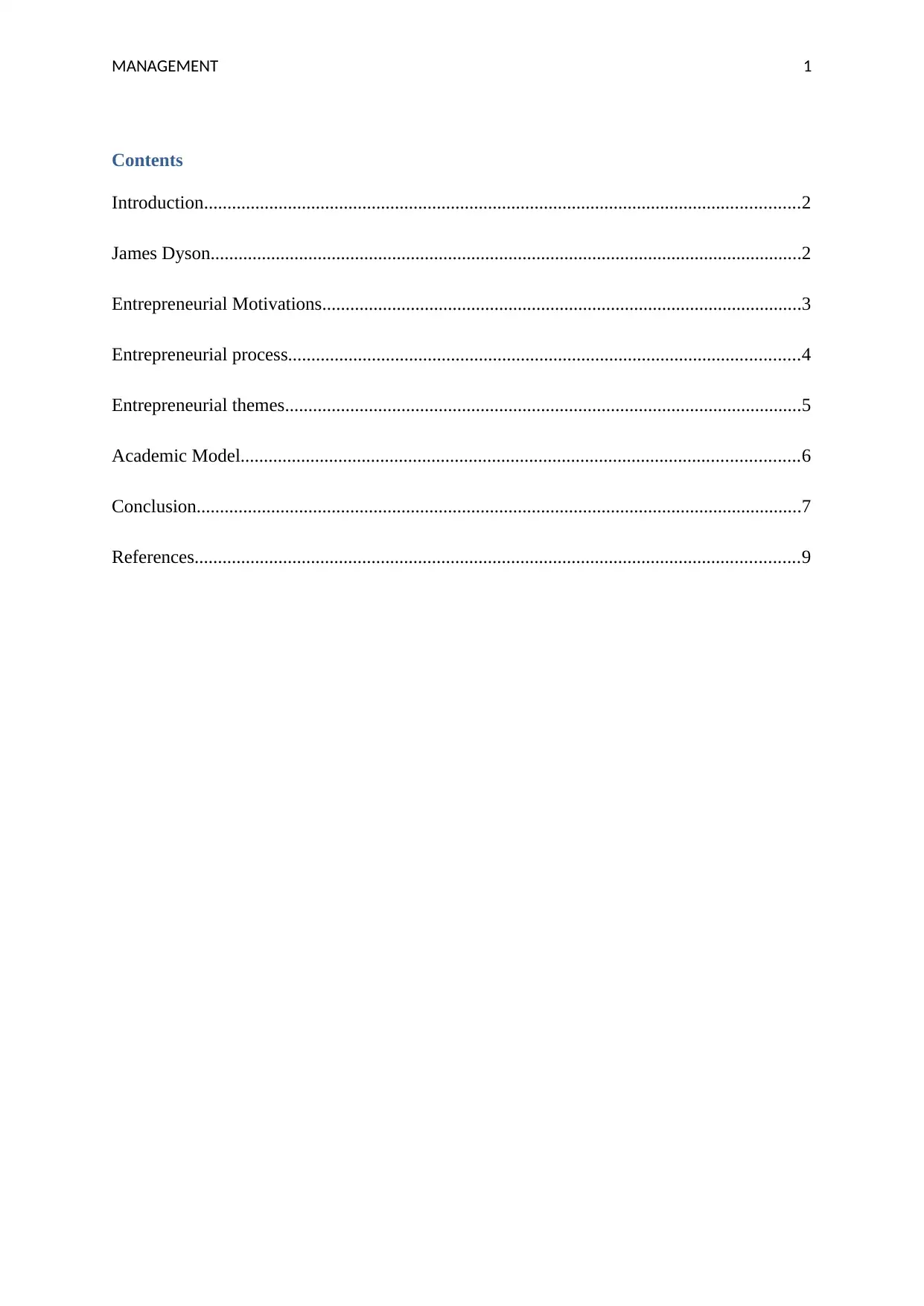
MANAGEMENT 1
Contents
Introduction................................................................................................................................2
James Dyson...............................................................................................................................2
Entrepreneurial Motivations.......................................................................................................3
Entrepreneurial process..............................................................................................................4
Entrepreneurial themes...............................................................................................................5
Academic Model........................................................................................................................6
Conclusion..................................................................................................................................7
References..................................................................................................................................9
Contents
Introduction................................................................................................................................2
James Dyson...............................................................................................................................2
Entrepreneurial Motivations.......................................................................................................3
Entrepreneurial process..............................................................................................................4
Entrepreneurial themes...............................................................................................................5
Academic Model........................................................................................................................6
Conclusion..................................................................................................................................7
References..................................................................................................................................9
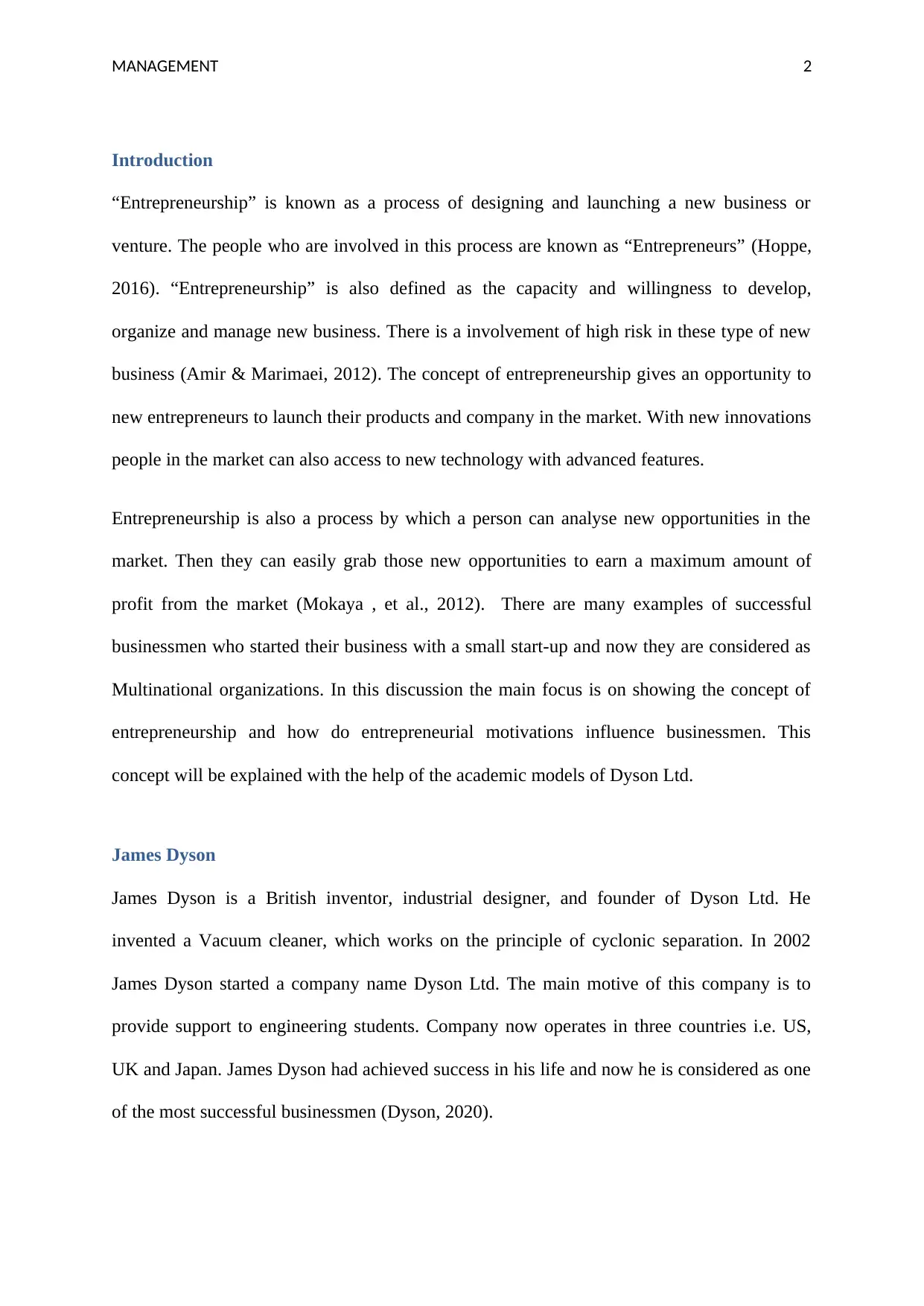
MANAGEMENT 2
Introduction
“Entrepreneurship” is known as a process of designing and launching a new business or
venture. The people who are involved in this process are known as “Entrepreneurs” (Hoppe,
2016). “Entrepreneurship” is also defined as the capacity and willingness to develop,
organize and manage new business. There is a involvement of high risk in these type of new
business (Amir & Marimaei, 2012). The concept of entrepreneurship gives an opportunity to
new entrepreneurs to launch their products and company in the market. With new innovations
people in the market can also access to new technology with advanced features.
Entrepreneurship is also a process by which a person can analyse new opportunities in the
market. Then they can easily grab those new opportunities to earn a maximum amount of
profit from the market (Mokaya , et al., 2012). There are many examples of successful
businessmen who started their business with a small start-up and now they are considered as
Multinational organizations. In this discussion the main focus is on showing the concept of
entrepreneurship and how do entrepreneurial motivations influence businessmen. This
concept will be explained with the help of the academic models of Dyson Ltd.
James Dyson
James Dyson is a British inventor, industrial designer, and founder of Dyson Ltd. He
invented a Vacuum cleaner, which works on the principle of cyclonic separation. In 2002
James Dyson started a company name Dyson Ltd. The main motive of this company is to
provide support to engineering students. Company now operates in three countries i.e. US,
UK and Japan. James Dyson had achieved success in his life and now he is considered as one
of the most successful businessmen (Dyson, 2020).
Introduction
“Entrepreneurship” is known as a process of designing and launching a new business or
venture. The people who are involved in this process are known as “Entrepreneurs” (Hoppe,
2016). “Entrepreneurship” is also defined as the capacity and willingness to develop,
organize and manage new business. There is a involvement of high risk in these type of new
business (Amir & Marimaei, 2012). The concept of entrepreneurship gives an opportunity to
new entrepreneurs to launch their products and company in the market. With new innovations
people in the market can also access to new technology with advanced features.
Entrepreneurship is also a process by which a person can analyse new opportunities in the
market. Then they can easily grab those new opportunities to earn a maximum amount of
profit from the market (Mokaya , et al., 2012). There are many examples of successful
businessmen who started their business with a small start-up and now they are considered as
Multinational organizations. In this discussion the main focus is on showing the concept of
entrepreneurship and how do entrepreneurial motivations influence businessmen. This
concept will be explained with the help of the academic models of Dyson Ltd.
James Dyson
James Dyson is a British inventor, industrial designer, and founder of Dyson Ltd. He
invented a Vacuum cleaner, which works on the principle of cyclonic separation. In 2002
James Dyson started a company name Dyson Ltd. The main motive of this company is to
provide support to engineering students. Company now operates in three countries i.e. US,
UK and Japan. James Dyson had achieved success in his life and now he is considered as one
of the most successful businessmen (Dyson, 2020).
⊘ This is a preview!⊘
Do you want full access?
Subscribe today to unlock all pages.

Trusted by 1+ million students worldwide
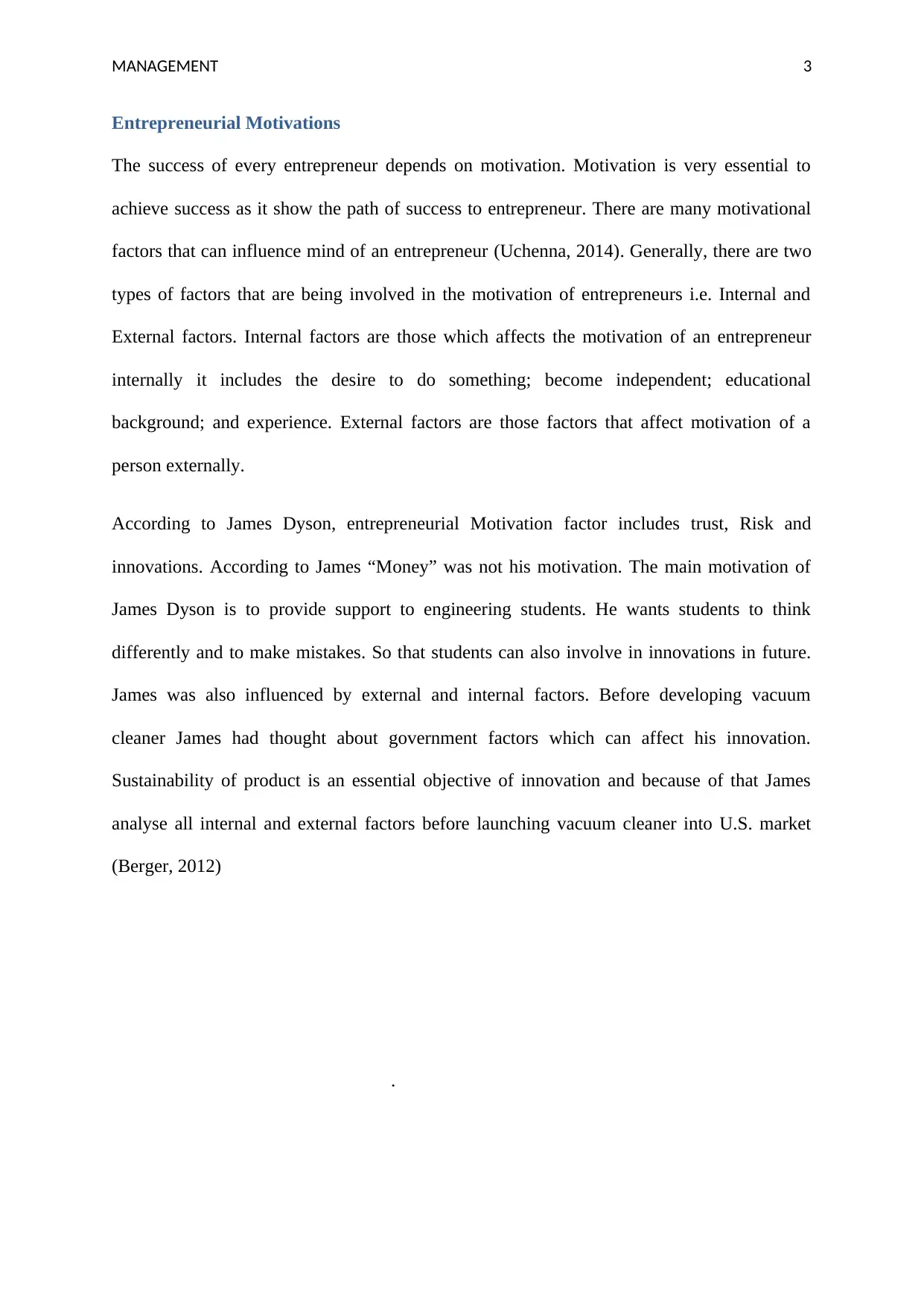
MANAGEMENT 3
Entrepreneurial Motivations
The success of every entrepreneur depends on motivation. Motivation is very essential to
achieve success as it show the path of success to entrepreneur. There are many motivational
factors that can influence mind of an entrepreneur (Uchenna, 2014). Generally, there are two
types of factors that are being involved in the motivation of entrepreneurs i.e. Internal and
External factors. Internal factors are those which affects the motivation of an entrepreneur
internally it includes the desire to do something; become independent; educational
background; and experience. External factors are those factors that affect motivation of a
person externally.
According to James Dyson, entrepreneurial Motivation factor includes trust, Risk and
innovations. According to James “Money” was not his motivation. The main motivation of
James Dyson is to provide support to engineering students. He wants students to think
differently and to make mistakes. So that students can also involve in innovations in future.
James was also influenced by external and internal factors. Before developing vacuum
cleaner James had thought about government factors which can affect his innovation.
Sustainability of product is an essential objective of innovation and because of that James
analyse all internal and external factors before launching vacuum cleaner into U.S. market
(Berger, 2012)
.
Entrepreneurial Motivations
The success of every entrepreneur depends on motivation. Motivation is very essential to
achieve success as it show the path of success to entrepreneur. There are many motivational
factors that can influence mind of an entrepreneur (Uchenna, 2014). Generally, there are two
types of factors that are being involved in the motivation of entrepreneurs i.e. Internal and
External factors. Internal factors are those which affects the motivation of an entrepreneur
internally it includes the desire to do something; become independent; educational
background; and experience. External factors are those factors that affect motivation of a
person externally.
According to James Dyson, entrepreneurial Motivation factor includes trust, Risk and
innovations. According to James “Money” was not his motivation. The main motivation of
James Dyson is to provide support to engineering students. He wants students to think
differently and to make mistakes. So that students can also involve in innovations in future.
James was also influenced by external and internal factors. Before developing vacuum
cleaner James had thought about government factors which can affect his innovation.
Sustainability of product is an essential objective of innovation and because of that James
analyse all internal and external factors before launching vacuum cleaner into U.S. market
(Berger, 2012)
.
Paraphrase This Document
Need a fresh take? Get an instant paraphrase of this document with our AI Paraphraser
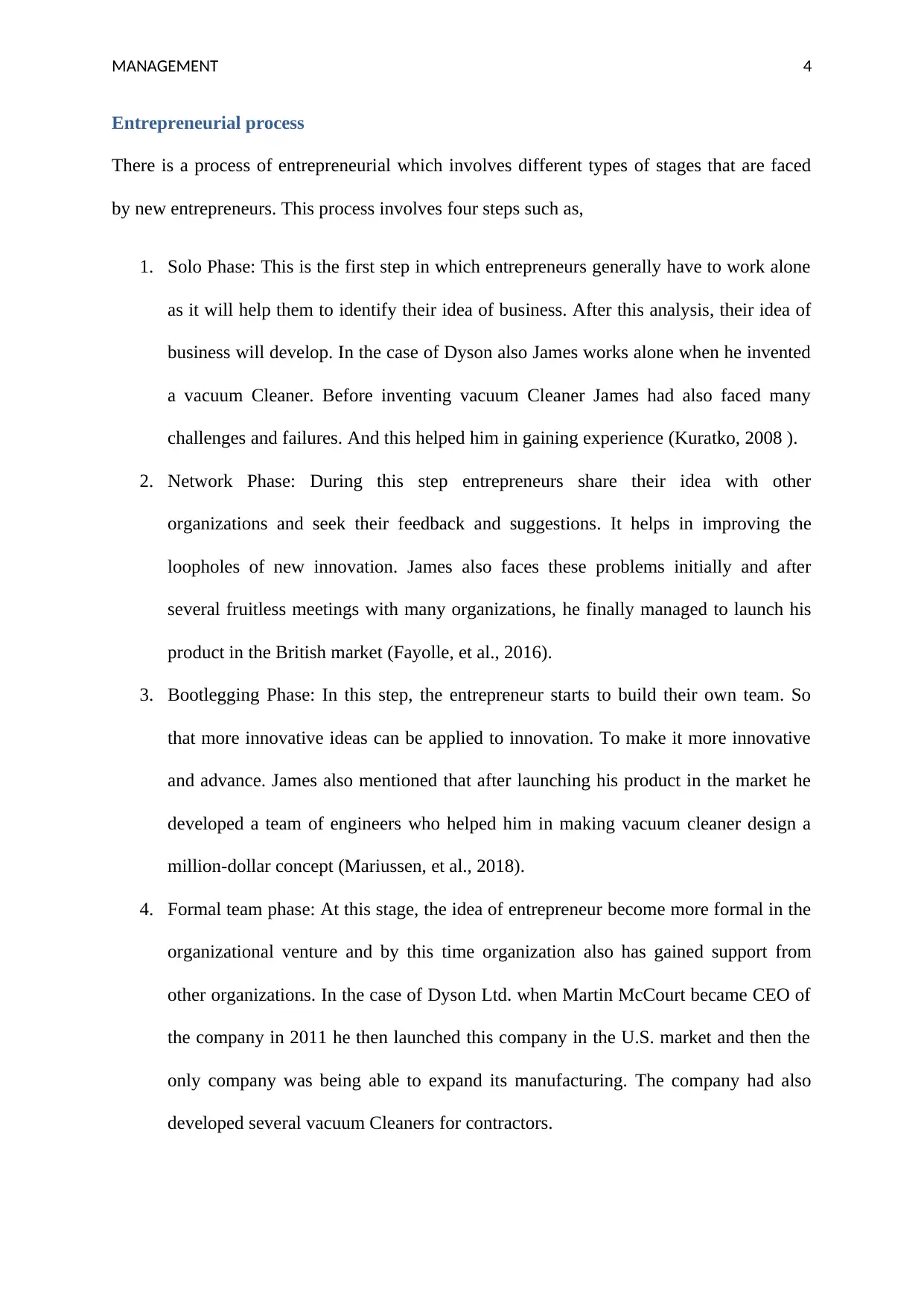
MANAGEMENT 4
Entrepreneurial process
There is a process of entrepreneurial which involves different types of stages that are faced
by new entrepreneurs. This process involves four steps such as,
1. Solo Phase: This is the first step in which entrepreneurs generally have to work alone
as it will help them to identify their idea of business. After this analysis, their idea of
business will develop. In the case of Dyson also James works alone when he invented
a vacuum Cleaner. Before inventing vacuum Cleaner James had also faced many
challenges and failures. And this helped him in gaining experience (Kuratko, 2008 ).
2. Network Phase: During this step entrepreneurs share their idea with other
organizations and seek their feedback and suggestions. It helps in improving the
loopholes of new innovation. James also faces these problems initially and after
several fruitless meetings with many organizations, he finally managed to launch his
product in the British market (Fayolle, et al., 2016).
3. Bootlegging Phase: In this step, the entrepreneur starts to build their own team. So
that more innovative ideas can be applied to innovation. To make it more innovative
and advance. James also mentioned that after launching his product in the market he
developed a team of engineers who helped him in making vacuum cleaner design a
million-dollar concept (Mariussen, et al., 2018).
4. Formal team phase: At this stage, the idea of entrepreneur become more formal in the
organizational venture and by this time organization also has gained support from
other organizations. In the case of Dyson Ltd. when Martin McCourt became CEO of
the company in 2011 he then launched this company in the U.S. market and then the
only company was being able to expand its manufacturing. The company had also
developed several vacuum Cleaners for contractors.
Entrepreneurial process
There is a process of entrepreneurial which involves different types of stages that are faced
by new entrepreneurs. This process involves four steps such as,
1. Solo Phase: This is the first step in which entrepreneurs generally have to work alone
as it will help them to identify their idea of business. After this analysis, their idea of
business will develop. In the case of Dyson also James works alone when he invented
a vacuum Cleaner. Before inventing vacuum Cleaner James had also faced many
challenges and failures. And this helped him in gaining experience (Kuratko, 2008 ).
2. Network Phase: During this step entrepreneurs share their idea with other
organizations and seek their feedback and suggestions. It helps in improving the
loopholes of new innovation. James also faces these problems initially and after
several fruitless meetings with many organizations, he finally managed to launch his
product in the British market (Fayolle, et al., 2016).
3. Bootlegging Phase: In this step, the entrepreneur starts to build their own team. So
that more innovative ideas can be applied to innovation. To make it more innovative
and advance. James also mentioned that after launching his product in the market he
developed a team of engineers who helped him in making vacuum cleaner design a
million-dollar concept (Mariussen, et al., 2018).
4. Formal team phase: At this stage, the idea of entrepreneur become more formal in the
organizational venture and by this time organization also has gained support from
other organizations. In the case of Dyson Ltd. when Martin McCourt became CEO of
the company in 2011 he then launched this company in the U.S. market and then the
only company was being able to expand its manufacturing. The company had also
developed several vacuum Cleaners for contractors.
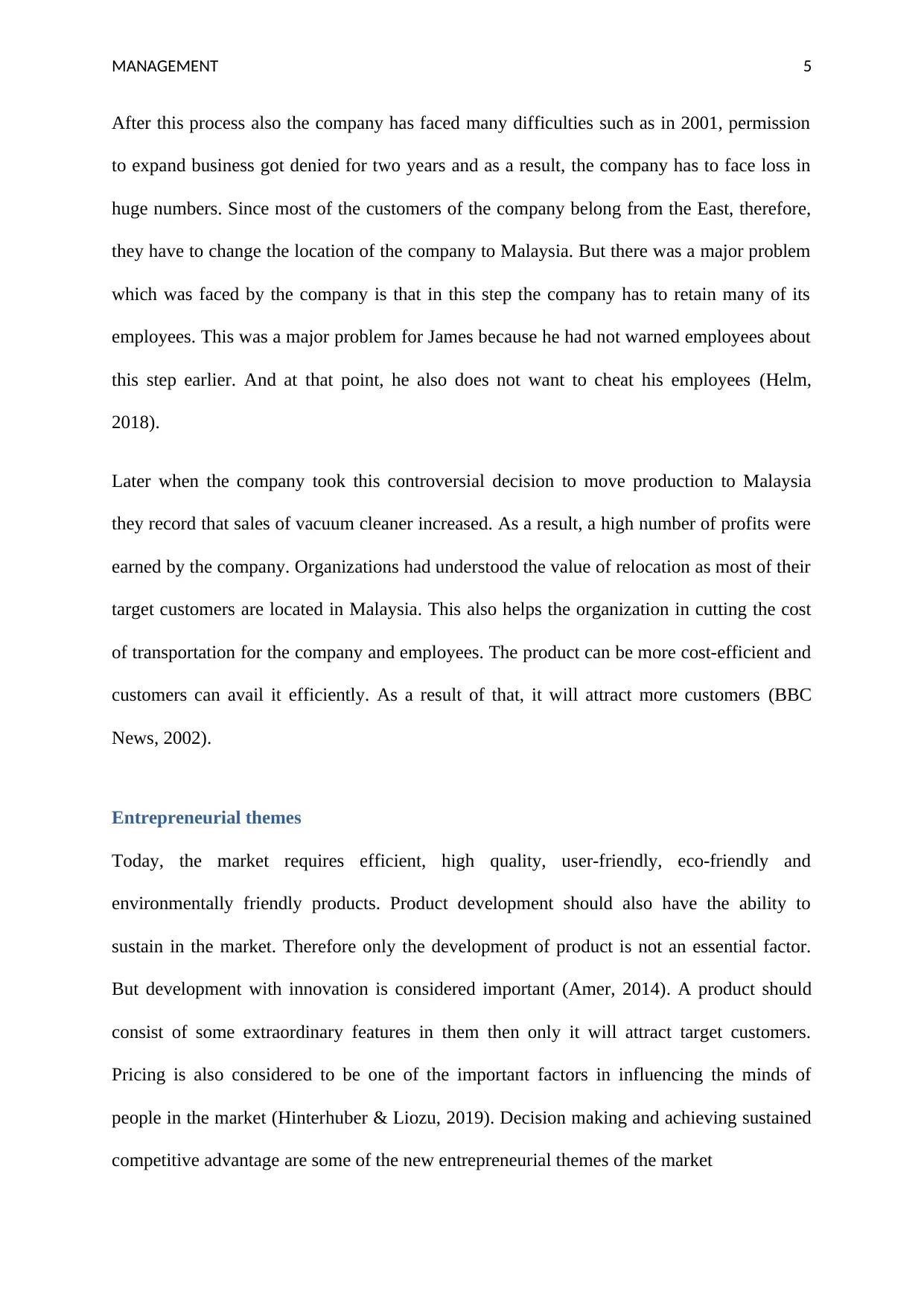
MANAGEMENT 5
After this process also the company has faced many difficulties such as in 2001, permission
to expand business got denied for two years and as a result, the company has to face loss in
huge numbers. Since most of the customers of the company belong from the East, therefore,
they have to change the location of the company to Malaysia. But there was a major problem
which was faced by the company is that in this step the company has to retain many of its
employees. This was a major problem for James because he had not warned employees about
this step earlier. And at that point, he also does not want to cheat his employees (Helm,
2018).
Later when the company took this controversial decision to move production to Malaysia
they record that sales of vacuum cleaner increased. As a result, a high number of profits were
earned by the company. Organizations had understood the value of relocation as most of their
target customers are located in Malaysia. This also helps the organization in cutting the cost
of transportation for the company and employees. The product can be more cost-efficient and
customers can avail it efficiently. As a result of that, it will attract more customers (BBC
News, 2002).
Entrepreneurial themes
Today, the market requires efficient, high quality, user-friendly, eco-friendly and
environmentally friendly products. Product development should also have the ability to
sustain in the market. Therefore only the development of product is not an essential factor.
But development with innovation is considered important (Amer, 2014). A product should
consist of some extraordinary features in them then only it will attract target customers.
Pricing is also considered to be one of the important factors in influencing the minds of
people in the market (Hinterhuber & Liozu, 2019). Decision making and achieving sustained
competitive advantage are some of the new entrepreneurial themes of the market
After this process also the company has faced many difficulties such as in 2001, permission
to expand business got denied for two years and as a result, the company has to face loss in
huge numbers. Since most of the customers of the company belong from the East, therefore,
they have to change the location of the company to Malaysia. But there was a major problem
which was faced by the company is that in this step the company has to retain many of its
employees. This was a major problem for James because he had not warned employees about
this step earlier. And at that point, he also does not want to cheat his employees (Helm,
2018).
Later when the company took this controversial decision to move production to Malaysia
they record that sales of vacuum cleaner increased. As a result, a high number of profits were
earned by the company. Organizations had understood the value of relocation as most of their
target customers are located in Malaysia. This also helps the organization in cutting the cost
of transportation for the company and employees. The product can be more cost-efficient and
customers can avail it efficiently. As a result of that, it will attract more customers (BBC
News, 2002).
Entrepreneurial themes
Today, the market requires efficient, high quality, user-friendly, eco-friendly and
environmentally friendly products. Product development should also have the ability to
sustain in the market. Therefore only the development of product is not an essential factor.
But development with innovation is considered important (Amer, 2014). A product should
consist of some extraordinary features in them then only it will attract target customers.
Pricing is also considered to be one of the important factors in influencing the minds of
people in the market (Hinterhuber & Liozu, 2019). Decision making and achieving sustained
competitive advantage are some of the new entrepreneurial themes of the market
⊘ This is a preview!⊘
Do you want full access?
Subscribe today to unlock all pages.

Trusted by 1+ million students worldwide
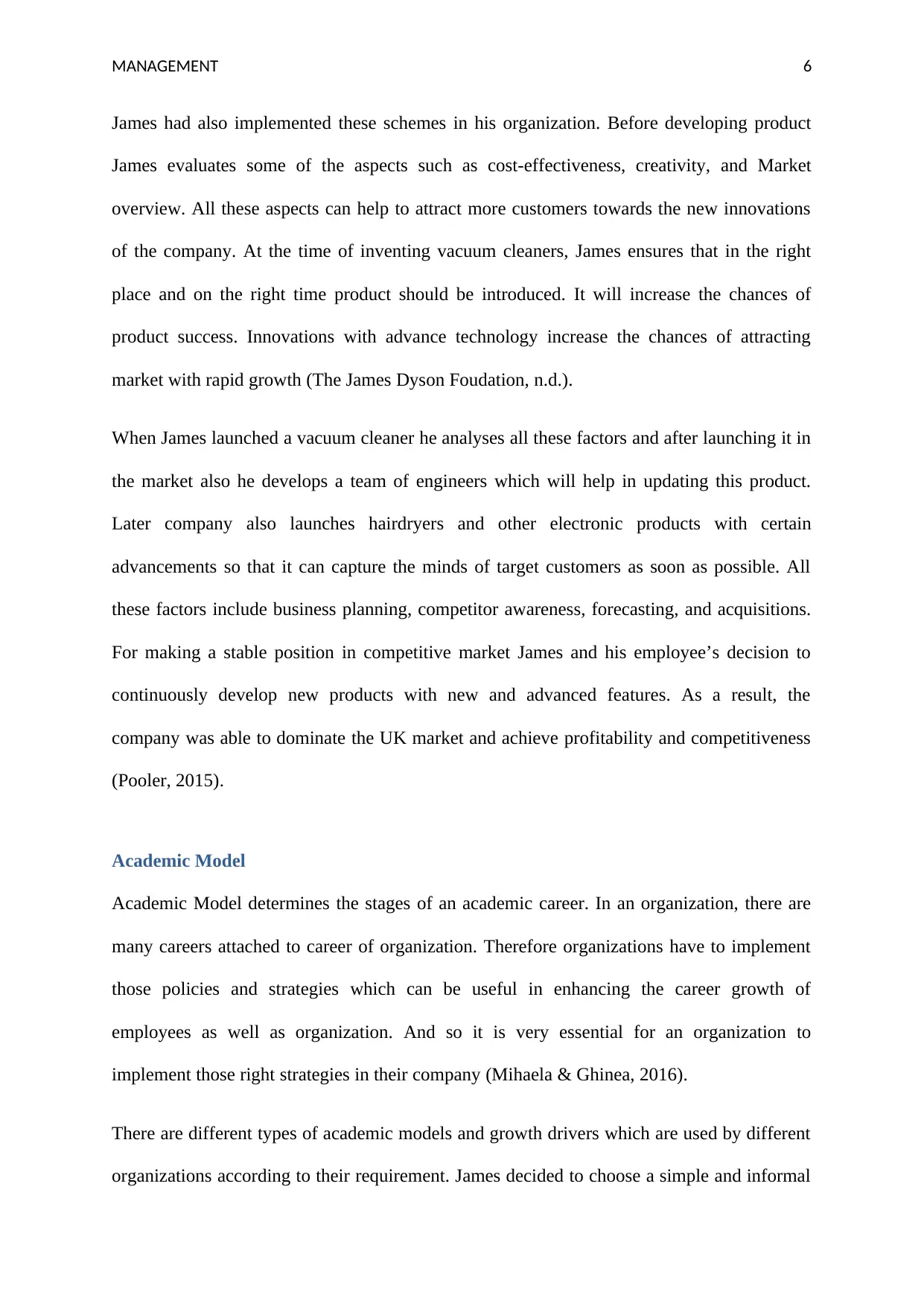
MANAGEMENT 6
James had also implemented these schemes in his organization. Before developing product
James evaluates some of the aspects such as cost-effectiveness, creativity, and Market
overview. All these aspects can help to attract more customers towards the new innovations
of the company. At the time of inventing vacuum cleaners, James ensures that in the right
place and on the right time product should be introduced. It will increase the chances of
product success. Innovations with advance technology increase the chances of attracting
market with rapid growth (The James Dyson Foudation, n.d.).
When James launched a vacuum cleaner he analyses all these factors and after launching it in
the market also he develops a team of engineers which will help in updating this product.
Later company also launches hairdryers and other electronic products with certain
advancements so that it can capture the minds of target customers as soon as possible. All
these factors include business planning, competitor awareness, forecasting, and acquisitions.
For making a stable position in competitive market James and his employee’s decision to
continuously develop new products with new and advanced features. As a result, the
company was able to dominate the UK market and achieve profitability and competitiveness
(Pooler, 2015).
Academic Model
Academic Model determines the stages of an academic career. In an organization, there are
many careers attached to career of organization. Therefore organizations have to implement
those policies and strategies which can be useful in enhancing the career growth of
employees as well as organization. And so it is very essential for an organization to
implement those right strategies in their company (Mihaela & Ghinea, 2016).
There are different types of academic models and growth drivers which are used by different
organizations according to their requirement. James decided to choose a simple and informal
James had also implemented these schemes in his organization. Before developing product
James evaluates some of the aspects such as cost-effectiveness, creativity, and Market
overview. All these aspects can help to attract more customers towards the new innovations
of the company. At the time of inventing vacuum cleaners, James ensures that in the right
place and on the right time product should be introduced. It will increase the chances of
product success. Innovations with advance technology increase the chances of attracting
market with rapid growth (The James Dyson Foudation, n.d.).
When James launched a vacuum cleaner he analyses all these factors and after launching it in
the market also he develops a team of engineers which will help in updating this product.
Later company also launches hairdryers and other electronic products with certain
advancements so that it can capture the minds of target customers as soon as possible. All
these factors include business planning, competitor awareness, forecasting, and acquisitions.
For making a stable position in competitive market James and his employee’s decision to
continuously develop new products with new and advanced features. As a result, the
company was able to dominate the UK market and achieve profitability and competitiveness
(Pooler, 2015).
Academic Model
Academic Model determines the stages of an academic career. In an organization, there are
many careers attached to career of organization. Therefore organizations have to implement
those policies and strategies which can be useful in enhancing the career growth of
employees as well as organization. And so it is very essential for an organization to
implement those right strategies in their company (Mihaela & Ghinea, 2016).
There are different types of academic models and growth drivers which are used by different
organizations according to their requirement. James decided to choose a simple and informal
Paraphrase This Document
Need a fresh take? Get an instant paraphrase of this document with our AI Paraphraser
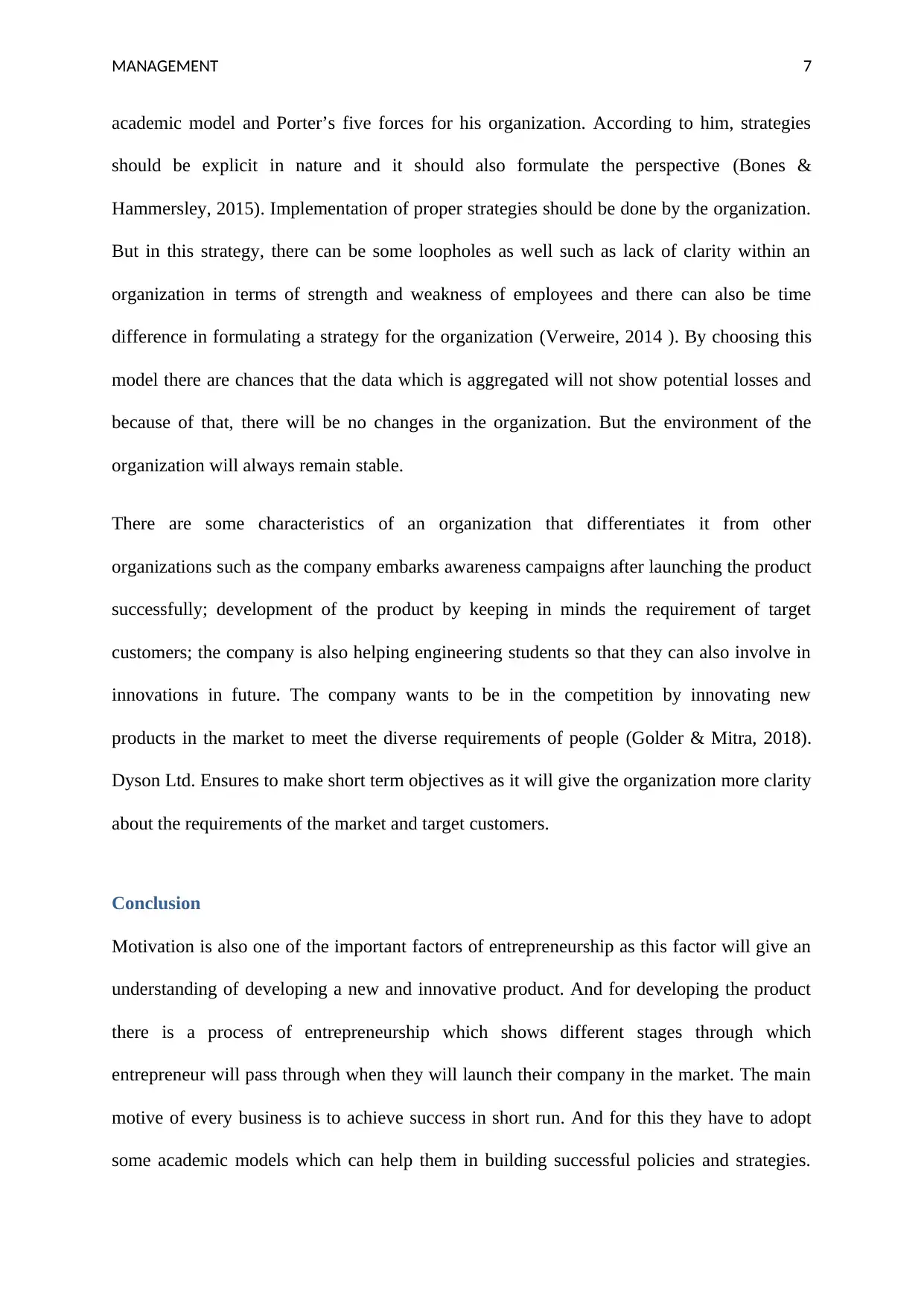
MANAGEMENT 7
academic model and Porter’s five forces for his organization. According to him, strategies
should be explicit in nature and it should also formulate the perspective (Bones &
Hammersley, 2015). Implementation of proper strategies should be done by the organization.
But in this strategy, there can be some loopholes as well such as lack of clarity within an
organization in terms of strength and weakness of employees and there can also be time
difference in formulating a strategy for the organization (Verweire, 2014 ). By choosing this
model there are chances that the data which is aggregated will not show potential losses and
because of that, there will be no changes in the organization. But the environment of the
organization will always remain stable.
There are some characteristics of an organization that differentiates it from other
organizations such as the company embarks awareness campaigns after launching the product
successfully; development of the product by keeping in minds the requirement of target
customers; the company is also helping engineering students so that they can also involve in
innovations in future. The company wants to be in the competition by innovating new
products in the market to meet the diverse requirements of people (Golder & Mitra, 2018).
Dyson Ltd. Ensures to make short term objectives as it will give the organization more clarity
about the requirements of the market and target customers.
Conclusion
Motivation is also one of the important factors of entrepreneurship as this factor will give an
understanding of developing a new and innovative product. And for developing the product
there is a process of entrepreneurship which shows different stages through which
entrepreneur will pass through when they will launch their company in the market. The main
motive of every business is to achieve success in short run. And for this they have to adopt
some academic models which can help them in building successful policies and strategies.
academic model and Porter’s five forces for his organization. According to him, strategies
should be explicit in nature and it should also formulate the perspective (Bones &
Hammersley, 2015). Implementation of proper strategies should be done by the organization.
But in this strategy, there can be some loopholes as well such as lack of clarity within an
organization in terms of strength and weakness of employees and there can also be time
difference in formulating a strategy for the organization (Verweire, 2014 ). By choosing this
model there are chances that the data which is aggregated will not show potential losses and
because of that, there will be no changes in the organization. But the environment of the
organization will always remain stable.
There are some characteristics of an organization that differentiates it from other
organizations such as the company embarks awareness campaigns after launching the product
successfully; development of the product by keeping in minds the requirement of target
customers; the company is also helping engineering students so that they can also involve in
innovations in future. The company wants to be in the competition by innovating new
products in the market to meet the diverse requirements of people (Golder & Mitra, 2018).
Dyson Ltd. Ensures to make short term objectives as it will give the organization more clarity
about the requirements of the market and target customers.
Conclusion
Motivation is also one of the important factors of entrepreneurship as this factor will give an
understanding of developing a new and innovative product. And for developing the product
there is a process of entrepreneurship which shows different stages through which
entrepreneur will pass through when they will launch their company in the market. The main
motive of every business is to achieve success in short run. And for this they have to adopt
some academic models which can help them in building successful policies and strategies.
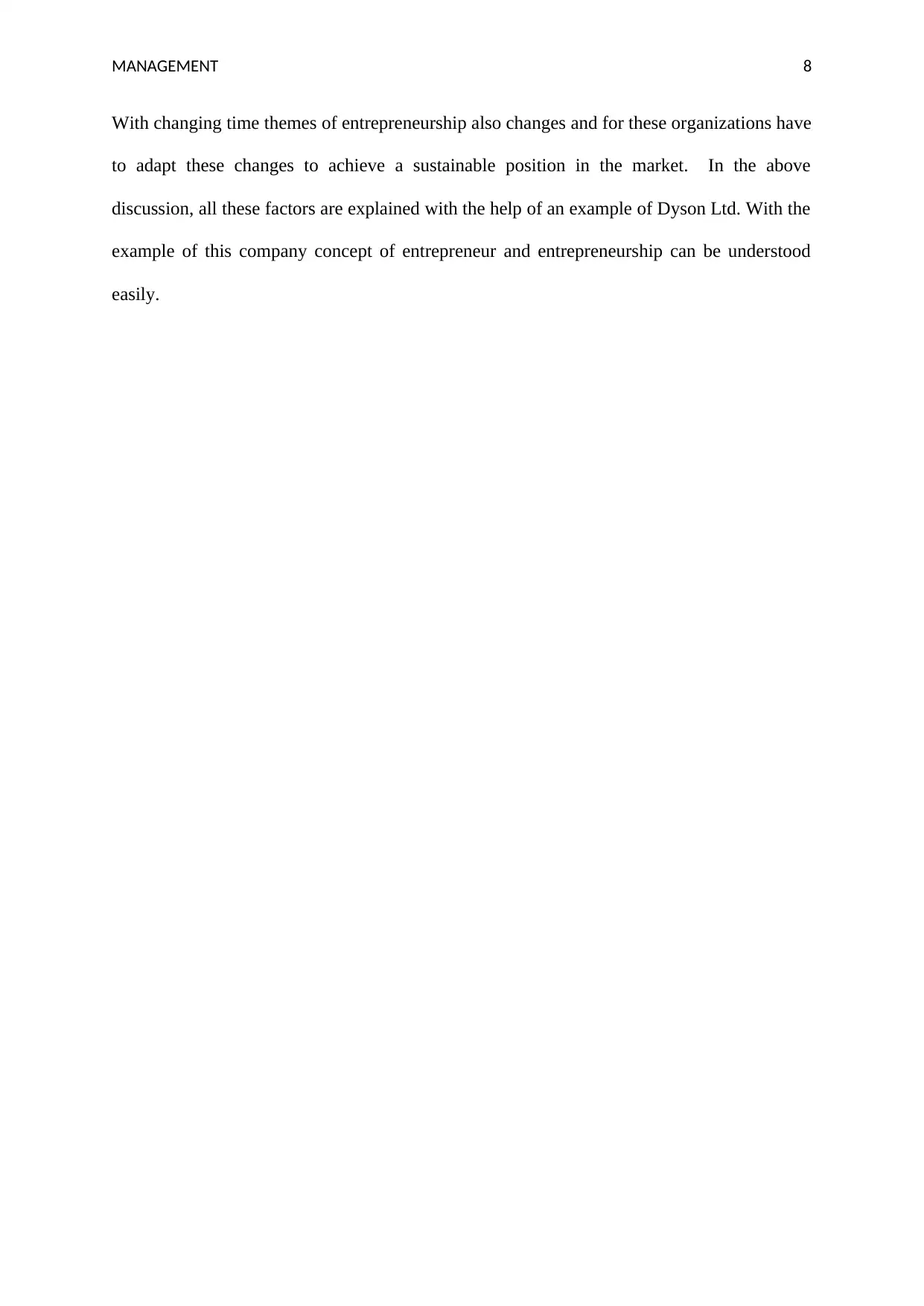
MANAGEMENT 8
With changing time themes of entrepreneurship also changes and for these organizations have
to adapt these changes to achieve a sustainable position in the market. In the above
discussion, all these factors are explained with the help of an example of Dyson Ltd. With the
example of this company concept of entrepreneur and entrepreneurship can be understood
easily.
With changing time themes of entrepreneurship also changes and for these organizations have
to adapt these changes to achieve a sustainable position in the market. In the above
discussion, all these factors are explained with the help of an example of Dyson Ltd. With the
example of this company concept of entrepreneur and entrepreneurship can be understood
easily.
⊘ This is a preview!⊘
Do you want full access?
Subscribe today to unlock all pages.

Trusted by 1+ million students worldwide
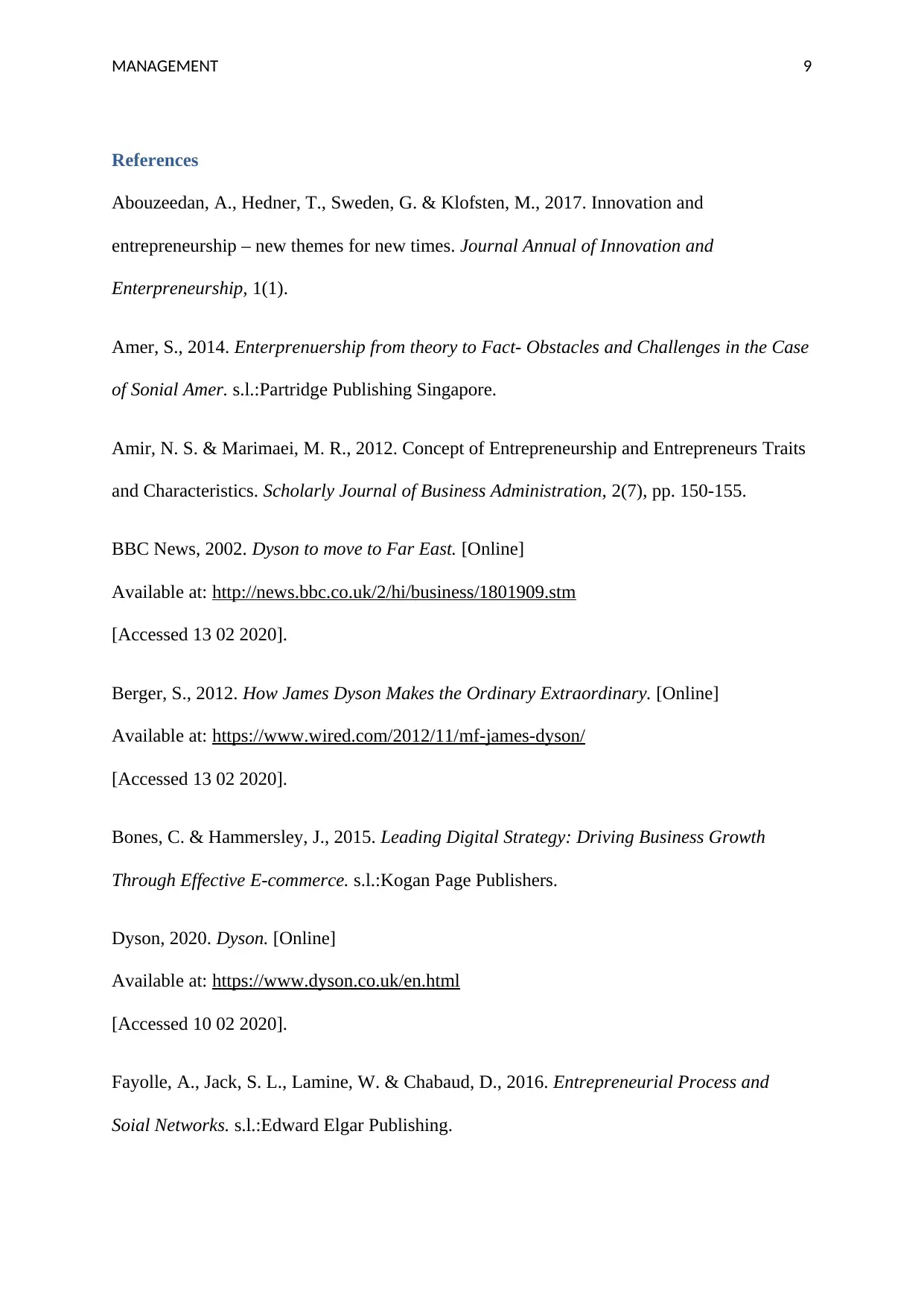
MANAGEMENT 9
References
Abouzeedan, A., Hedner, T., Sweden, G. & Klofsten, M., 2017. Innovation and
entrepreneurship – new themes for new times. Journal Annual of Innovation and
Enterpreneurship, 1(1).
Amer, S., 2014. Enterprenuership from theory to Fact- Obstacles and Challenges in the Case
of Sonial Amer. s.l.:Partridge Publishing Singapore.
Amir, N. S. & Marimaei, M. R., 2012. Concept of Entrepreneurship and Entrepreneurs Traits
and Characteristics. Scholarly Journal of Business Administration, 2(7), pp. 150-155.
BBC News, 2002. Dyson to move to Far East. [Online]
Available at: http://news.bbc.co.uk/2/hi/business/1801909.stm
[Accessed 13 02 2020].
Berger, S., 2012. How James Dyson Makes the Ordinary Extraordinary. [Online]
Available at: https://www.wired.com/2012/11/mf-james-dyson/
[Accessed 13 02 2020].
Bones, C. & Hammersley, J., 2015. Leading Digital Strategy: Driving Business Growth
Through Effective E-commerce. s.l.:Kogan Page Publishers.
Dyson, 2020. Dyson. [Online]
Available at: https://www.dyson.co.uk/en.html
[Accessed 10 02 2020].
Fayolle, A., Jack, S. L., Lamine, W. & Chabaud, D., 2016. Entrepreneurial Process and
Soial Networks. s.l.:Edward Elgar Publishing.
References
Abouzeedan, A., Hedner, T., Sweden, G. & Klofsten, M., 2017. Innovation and
entrepreneurship – new themes for new times. Journal Annual of Innovation and
Enterpreneurship, 1(1).
Amer, S., 2014. Enterprenuership from theory to Fact- Obstacles and Challenges in the Case
of Sonial Amer. s.l.:Partridge Publishing Singapore.
Amir, N. S. & Marimaei, M. R., 2012. Concept of Entrepreneurship and Entrepreneurs Traits
and Characteristics. Scholarly Journal of Business Administration, 2(7), pp. 150-155.
BBC News, 2002. Dyson to move to Far East. [Online]
Available at: http://news.bbc.co.uk/2/hi/business/1801909.stm
[Accessed 13 02 2020].
Berger, S., 2012. How James Dyson Makes the Ordinary Extraordinary. [Online]
Available at: https://www.wired.com/2012/11/mf-james-dyson/
[Accessed 13 02 2020].
Bones, C. & Hammersley, J., 2015. Leading Digital Strategy: Driving Business Growth
Through Effective E-commerce. s.l.:Kogan Page Publishers.
Dyson, 2020. Dyson. [Online]
Available at: https://www.dyson.co.uk/en.html
[Accessed 10 02 2020].
Fayolle, A., Jack, S. L., Lamine, W. & Chabaud, D., 2016. Entrepreneurial Process and
Soial Networks. s.l.:Edward Elgar Publishing.
Paraphrase This Document
Need a fresh take? Get an instant paraphrase of this document with our AI Paraphraser
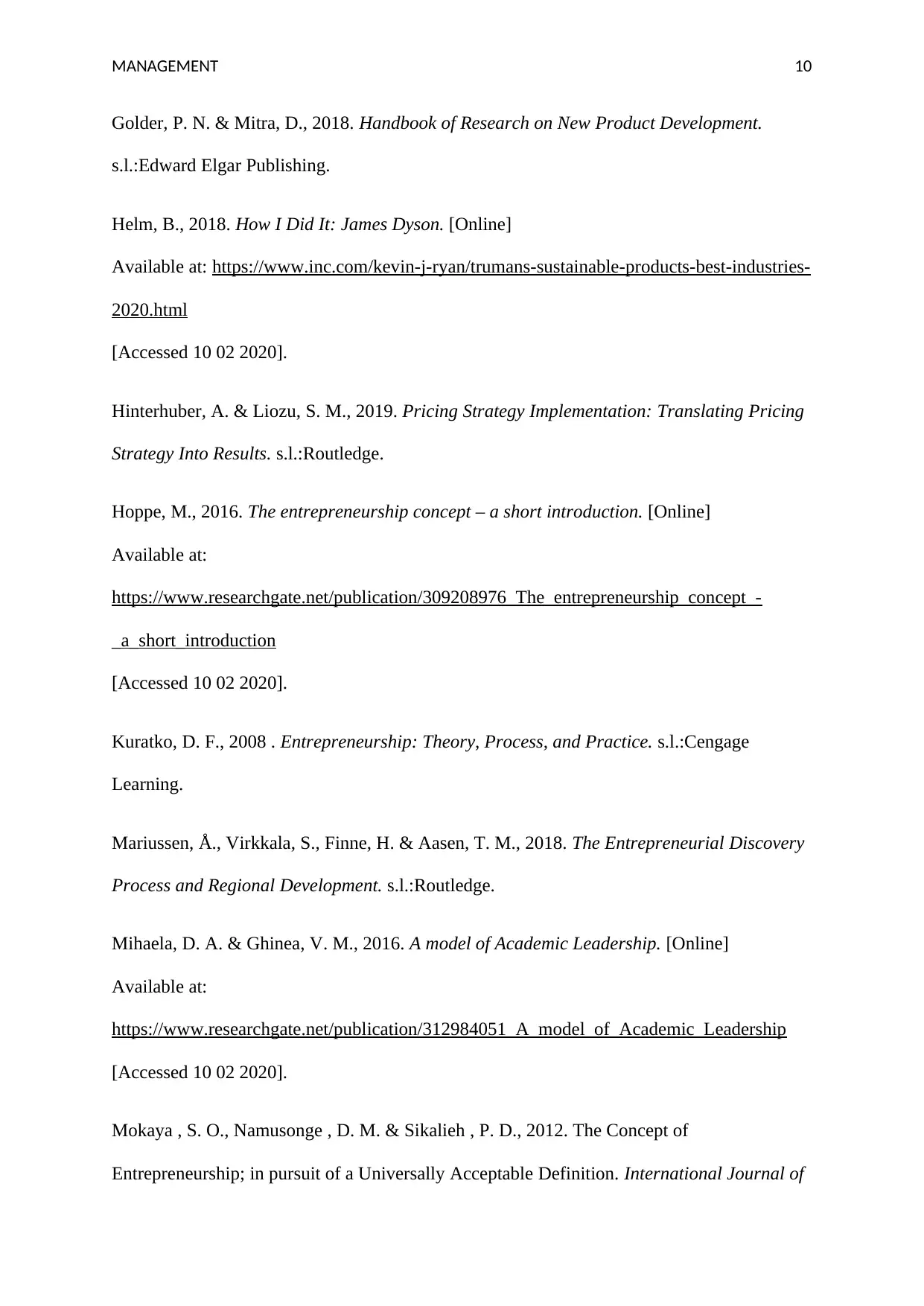
MANAGEMENT 10
Golder, P. N. & Mitra, D., 2018. Handbook of Research on New Product Development.
s.l.:Edward Elgar Publishing.
Helm, B., 2018. How I Did It: James Dyson. [Online]
Available at: https://www.inc.com/kevin-j-ryan/trumans-sustainable-products-best-industries-
2020.html
[Accessed 10 02 2020].
Hinterhuber, A. & Liozu, S. M., 2019. Pricing Strategy Implementation: Translating Pricing
Strategy Into Results. s.l.:Routledge.
Hoppe, M., 2016. The entrepreneurship concept – a short introduction. [Online]
Available at:
https://www.researchgate.net/publication/309208976_The_entrepreneurship_concept_-
_a_short_introduction
[Accessed 10 02 2020].
Kuratko, D. F., 2008 . Entrepreneurship: Theory, Process, and Practice. s.l.:Cengage
Learning.
Mariussen, Å., Virkkala, S., Finne, H. & Aasen, T. M., 2018. The Entrepreneurial Discovery
Process and Regional Development. s.l.:Routledge.
Mihaela, D. A. & Ghinea, V. M., 2016. A model of Academic Leadership. [Online]
Available at:
https://www.researchgate.net/publication/312984051_A_model_of_Academic_Leadership
[Accessed 10 02 2020].
Mokaya , S. O., Namusonge , D. M. & Sikalieh , P. D., 2012. The Concept of
Entrepreneurship; in pursuit of a Universally Acceptable Definition. International Journal of
Golder, P. N. & Mitra, D., 2018. Handbook of Research on New Product Development.
s.l.:Edward Elgar Publishing.
Helm, B., 2018. How I Did It: James Dyson. [Online]
Available at: https://www.inc.com/kevin-j-ryan/trumans-sustainable-products-best-industries-
2020.html
[Accessed 10 02 2020].
Hinterhuber, A. & Liozu, S. M., 2019. Pricing Strategy Implementation: Translating Pricing
Strategy Into Results. s.l.:Routledge.
Hoppe, M., 2016. The entrepreneurship concept – a short introduction. [Online]
Available at:
https://www.researchgate.net/publication/309208976_The_entrepreneurship_concept_-
_a_short_introduction
[Accessed 10 02 2020].
Kuratko, D. F., 2008 . Entrepreneurship: Theory, Process, and Practice. s.l.:Cengage
Learning.
Mariussen, Å., Virkkala, S., Finne, H. & Aasen, T. M., 2018. The Entrepreneurial Discovery
Process and Regional Development. s.l.:Routledge.
Mihaela, D. A. & Ghinea, V. M., 2016. A model of Academic Leadership. [Online]
Available at:
https://www.researchgate.net/publication/312984051_A_model_of_Academic_Leadership
[Accessed 10 02 2020].
Mokaya , S. O., Namusonge , D. M. & Sikalieh , P. D., 2012. The Concept of
Entrepreneurship; in pursuit of a Universally Acceptable Definition. International Journal of
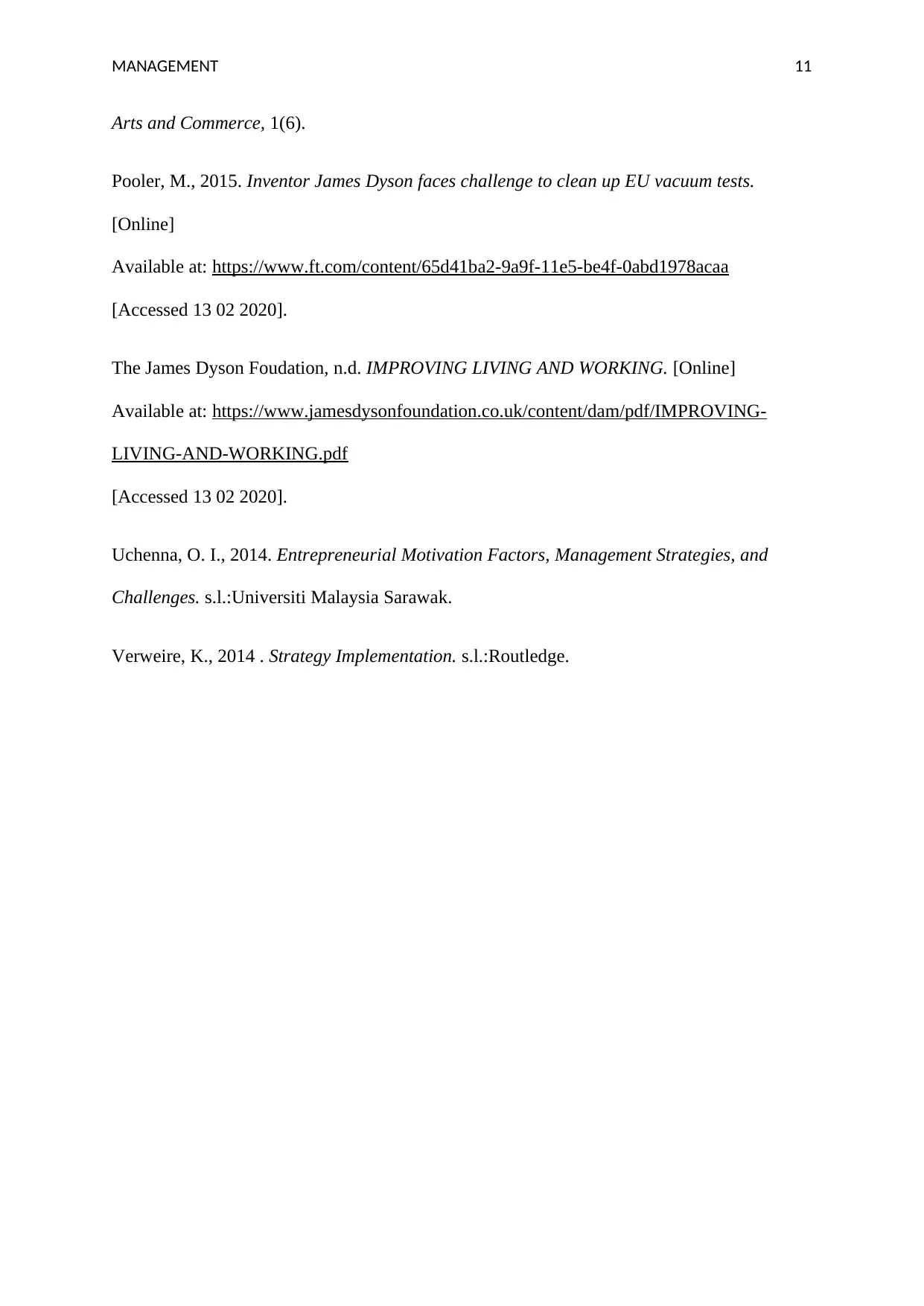
MANAGEMENT 11
Arts and Commerce, 1(6).
Pooler, M., 2015. Inventor James Dyson faces challenge to clean up EU vacuum tests.
[Online]
Available at: https://www.ft.com/content/65d41ba2-9a9f-11e5-be4f-0abd1978acaa
[Accessed 13 02 2020].
The James Dyson Foudation, n.d. IMPROVING LIVING AND WORKING. [Online]
Available at: https://www.jamesdysonfoundation.co.uk/content/dam/pdf/IMPROVING-
LIVING-AND-WORKING.pdf
[Accessed 13 02 2020].
Uchenna, O. I., 2014. Entrepreneurial Motivation Factors, Management Strategies, and
Challenges. s.l.:Universiti Malaysia Sarawak.
Verweire, K., 2014 . Strategy Implementation. s.l.:Routledge.
Arts and Commerce, 1(6).
Pooler, M., 2015. Inventor James Dyson faces challenge to clean up EU vacuum tests.
[Online]
Available at: https://www.ft.com/content/65d41ba2-9a9f-11e5-be4f-0abd1978acaa
[Accessed 13 02 2020].
The James Dyson Foudation, n.d. IMPROVING LIVING AND WORKING. [Online]
Available at: https://www.jamesdysonfoundation.co.uk/content/dam/pdf/IMPROVING-
LIVING-AND-WORKING.pdf
[Accessed 13 02 2020].
Uchenna, O. I., 2014. Entrepreneurial Motivation Factors, Management Strategies, and
Challenges. s.l.:Universiti Malaysia Sarawak.
Verweire, K., 2014 . Strategy Implementation. s.l.:Routledge.
⊘ This is a preview!⊘
Do you want full access?
Subscribe today to unlock all pages.

Trusted by 1+ million students worldwide
1 out of 12
Related Documents
Your All-in-One AI-Powered Toolkit for Academic Success.
+13062052269
info@desklib.com
Available 24*7 on WhatsApp / Email
![[object Object]](/_next/static/media/star-bottom.7253800d.svg)
Unlock your academic potential
Copyright © 2020–2025 A2Z Services. All Rights Reserved. Developed and managed by ZUCOL.




